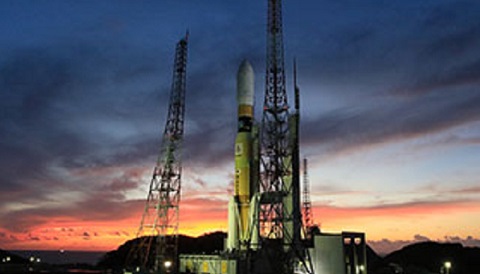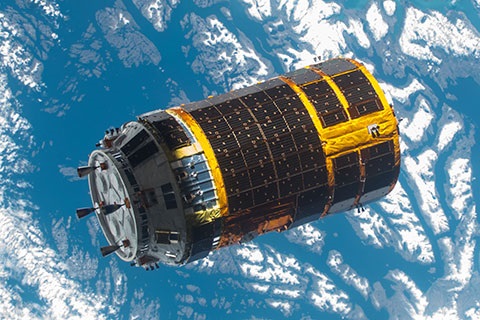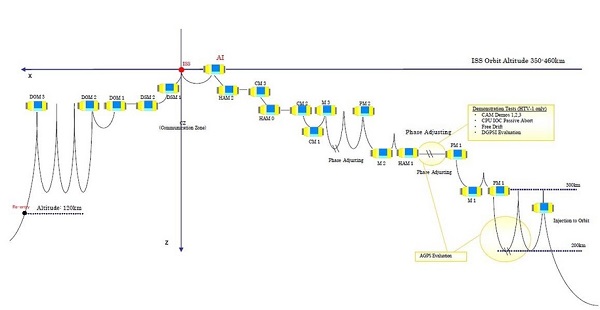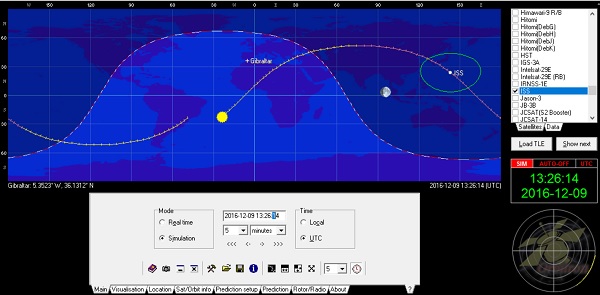A cargo mission launched today to resupply the International Space Station. Watch it approach the International Space Station this weekend.

JAXA
Got a pass of the International Space Station (ISS) this weekend? Watch carefully, and you might just see an additional visitor: the Japanese H-II Transfer Vehicle HTV-6 cargo mission, launching today.
HTV-6 Kounotori ("white stork" in Japanese) launches today at 8:26 a.m. EST / 13:26 UT atop an H-2B rocket from Tanegashima Space Center on the southern tip of Kyushu Island in Japan. Headed toward an orbit matching the ISS at 256 miles (410 kilometers) above the Earth's surface, grapple and capture of the HTV-6 will be broadcast live on NASA TV on Tuesday, December 13th, starting at 4:30 a.m. EST / 9:30 UT. Capture for berthing of HTV-6 to the nadir node of the Harmony module is expected to occur at 6:00 a.m. EST /11:00 UT.
Watch the launch here (launch countdown begins around 59:30 into the video):
What Is HTV-6?

NASA/JAXA
HTV-6 carries 5.9 metric tons of cargo, including food, water and experiments for the ISS. Also on the manifest are new lithium ion batteries set to replace the aging nickel-hydride batteries used for power while the ISS is in Earth's shadow. HTV-6 will undock for a destructive reentry in early 2017.
This cargo supply flight comes just over a week after the loss of the Russian Progress-65 mission just six minutes after liftoff from the Baikonur Cosmodrome on December 1st.
Prospects for Spotting HTV-6
HTV-6 launches five minutes behind the ISS on its 90-minute orbit around Earth. After achieving its initial orbit, HTV-6 will need to perform a series of engine burns over the next several days to boost its orbit further and reach the ISS.
If the ISS will be passing overhead this weekend (check for ISS passes for your location here), it's worth watching a few minutes before and after to find the HTV-6 spacecraft along the same course. We spied the last HTV-5 module chasing the ISS through the Florida dawn as a +1-magnitude star-like object back in 2015.

NASA
The closer it gets to grapple and berthing on Tuesday, the closer the HTV-6 will be to the brilliant ISS. ISS passes starting Friday night favor latitudes 40° to 55° north (including the United Kingdom and the northern tier of the contiguous United States and southern Canada) for dusk passes, and 30° to 45° south latitude (including New Zealand and the southern tip of South America) for dawn passes.
Heavens-Above is a great place to find ISS passes for your locale, as is NASA's Spot the Station. All predictions stem from U.S. Joint Space Operations Command (JSpOC), which publishes public Two Line Elements (TLEs) for unclassified missions shortly after launch. Registered users can access TLEs on the Space-Track website. We like to manually check these prior to an ISS pass and plug them in to a nifty satellite tracking application named Orbitron.

Orbitron
Too much work? Follow us on Twitter (we're @Astroguyz) and we'll update sighting prospects for the HTV-6 versus the ISS worldwide post launch.
HTV-6 isn't the only mission that occasionally stalks the ISS. Russian Progress vehicles, the European Space Agency's ATV spacecraft, SpaceX's Dragon and Orbital ATK's Cygnus all make port of calls at the station. The Russian Soyuz spacecraft also make a few flights a year, and are currently the only way crew can reach and depart the ISS. SpaceX's Dragon also provides the only automated down-mass return capability from the ISS, splashing down in the Pacific.
The second stages of these missions also sometimes remain along the path of the ISS for a few days post-launch, although in the case of an H-2B rocket shot, the second stage usually reenters over the Pacific shortly after launch.
Some near-future flights to the ISS to watch out for include: SpaceX's Dragon on CRS-10 (January 22nd), Progress-66P (February 2nd), and Cygnus on OA-7 (March 16th). Dragon launches are particularly dramatic, as they generate four pieces of hardware (Dragon, the Falcon second stage, and the two solar panel covers) often spotted on the first orbital pass.
Don't miss the ISS and friends, crossing a sky near you!
 1
1









Comments
Gerald-Hanner
December 11, 2016 at 11:53 am
I once saw one of the space shuttles just after separation from ISS.
You must be logged in to post a comment.
You must be logged in to post a comment.